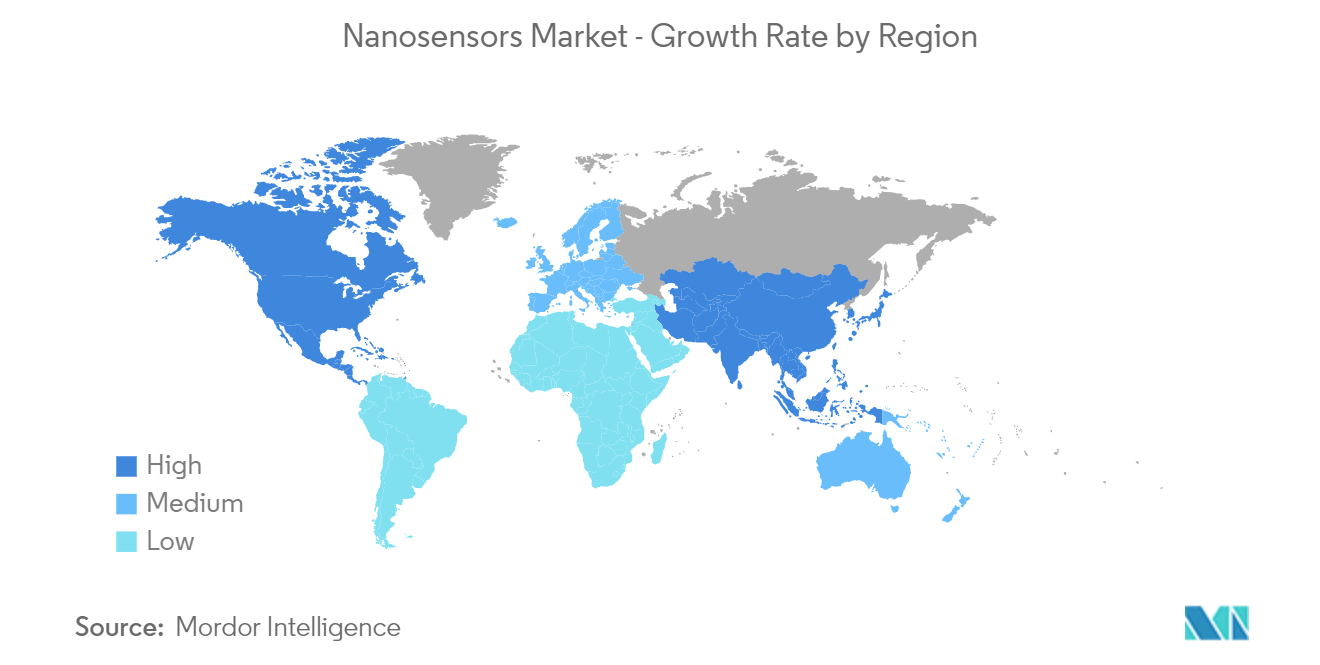Market Trends of Nanosensors Industry
Healthcare Industry to Show Significant Growth
The healthcare industry holds a significant share of the nanosensor market. A crucial aspect of diagnostic medicine is making quick, sensitive, and accurate detections. Since many conditions have symptoms that may not manifest until the condition has advanced to stages that may be challenging to cure, early diagnosis of diseases is crucial. Real-time monitoring is a popular method of using nanosensors in diagnostics to quickly diagnose disorders.
The market is anticipated to be driven by the increasing prevalence of skin cancer worldwide. For instance, skin cancer affects roughly 9,400 individuals in the United States daily, and over two people pass away every hour. According to the American Cancer Society (ACS), in 2023, the estimated number of melanoma of skin cases in the United States is anticipated to reach 58,120 in males and 39,490 in females.
Skin cancer is treated with the application of nanomedicine. In this manner, targeted tumor locations and target cells can be effectively treated with drugs and other medical therapies while minimizing adverse effects. A new technique dubbed Nano Flares for detecting malignant cells in the blood was developed using nanomedicine. Thus, market expansion during the forecast period is anticipated to be driven by the increased use of nanosensors in medications to treat skin malignancies.
Additionally, using nanosensors in skin cancer treatment allows for the effective delivery of medications and other treatments to particular tumor locations and target cells with little in the way of hazardous side effects. Moreover, Smart pills refer to nano-level electronic devices modeled and designed like pharmaceutical pills but perform more sophisticated sensing, imaging, and drug delivery functions. Nanotechnology has previously helped the development of various types of smart pills, such as the PillCam, capsules with mini-video cameras, and dose-sensing pills.
Due to their ability to identify diseases early without the need for external indications, nanosensors have tremendous promise for use in diagnostic medicine in the region. Ideal nanosensor implementations attempt to imitate the response of immune cells in the body by combining diagnostic and resistant response features, providing data to enable monitoring of the sensor input and response, and so on. Additionally, organ implants can be inspected with nanosensors for contamination. When it notices contamination in the cells surrounding the implant, the implanted nanosensor transmits an electric signal to a physician or other healthcare provider. The nanosensor determines whether the cells are healthy, irritated, or contaminated with bacteria.
Furthermore, many regional companies focus on developing therapeutic options using nanotechnology platforms for dispensing antiretroviral drugs, ultimately driving the nanosensor market. Nanotechnological applications in drug development and delivery promise to combat and resolve problems related to HIV treatment by enabling the development of drugs with pharmacological advantages pioneered by different materials properties at the nanoscale compared to the bulk, atomic scale, or molecular dimensions.

North America to Hold a Significant Market Share
The global nanosensor market's largest share ultimately belonged to the North American market. The area's existing infrastructure and significant Nano Sensors providers are among the major reason behind this. Manufacturers of nanosensors in the area are researching how nanosensors may be used further in various industries. This could lead to the development of advanced nanosensor products.
The primary factor driving the nanosensors market in North America is a growing demand for nanosensors in the military and homeland security, as they are used for detecting radiation and biotoxins. As nanosensors have also benefited the military by helping develop advanced Warfield gear, such as lighter vehicles and self-repairing tents, the increased defense budget of the region, specifically the United States, is expected to drive the demand for nanosensors. For instance, according to the United States Department of Defense, the budget for a request for the fiscal year 2022 rose to USD 722 billion, which earns a defense budget increase of USD 17 billion from 2021.
Furthermore, using nanosensors in aircraft also drives their demand in the region, as the United States is among the leading manufacturers and consumers of commercial and military aircraft. For instance, in aircraft, sensors are crucial for sensing a variety of indicators, including fuel levels, environmental conditions, and performance updates. When added to these sensor systems, nanosensors can increase their sensitivity and reduce their overall weight.
Moreover, cost-effective manufacturing due to the compactness of nanosensors is set to bring about a positive transition in the nanosensors market. Moreover, the increasing demand for smaller and faster portable diagnostic sensing systems is the primary factor driving the growth of nanotechnology in North America's biomedical and healthcare segment. All these factors contribute to the increasing demand for nanosensors in North America.
Additionally, businesses in the area are concentrating on creating smart packaging, one of the region's safest food packaging options. It belongs to the smart packaging category, which uses nanosensors to react to physical or chemical changes in food samples held within the packaging to avoid contamination or deterioration.


